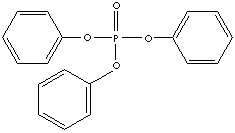| TRIPHENYL PHOSPHATE | ||
|
PRODUCT IDENTIFICATION |
||
| CAS NO. | 115-86-6 |
|
| EINECS NO. | 204-112-2 | |
| FORMULA | (C6H5O)3PO | |
| MOL WT. | 3296.29 | |
| H.S. CODE | 2919.00 | |
| TOXICITY | Oral rat LD50: 3500 mg/kg | |
| SYNONYMS | Phosphoric Acid Triphenyl Ester; Fosfato de trifenilo (Spanish); | |
| Phosphate de Triphenyle; TPP; Trifenylfosfat; Triphenoxyphosphine Oxide; Phosphate de triphényle (French); | ||
| SMILES | from phosphorus oxychloride and phenol | |
|
CLASSIFICATION |
|
|
|
PHYSICAL AND CHEMICAL PROPERTIES |
||
| PHYSICAL STATE |
white to off-white flake or crystal |
|
| MELTING POINT | 49 - 51 C | |
| BOILING POINT | 245 C | |
| SPECIFIC GRAVITY | 1.185-1.202 | |
| SOLUBILITY IN WATER | Insoluble | |
|
SOLVENT SOLUBILITY |
Soluble: Chloroform, Carbon Tetrachloride, Ether, Benzene; moderately soluble in ethanol | |
| AUTOIGNITION |
500 C |
|
| pH | ||
| VAPOR DENSITY | ||
| NFPA RATINGS | Health : 2 Flammability : 1 Reactivity : 0 | |
| REFRACTIVE INDEX | 1.552-1.563 | |
| FLASH POINT |
220 C |
|
| STABILITY | Stable under ordinary conditions | |
|
APPLICATIONS |
||
|
TPP is a non-flammable crystalline compound; melts at 49-50 C; soluble in
benzene, chloroform, ether, and acetone. It hydrolyses rapidly in alkaline
solutions at normal ambient temperature to give phosphoric acid, diphenyl
phosphate and phenol, readily hydrolyses in strong acidic conditions at high
temperature but slowly in acidic and neutral solutions. TPP is used as;
·
Flame-retardant in many plastics and reins especially in phenolic
resin for the |
||
| SALES SPECIFICATION | ||
|
APPEARANCE |
white to off-white flake or crystal |
|
| COLOR, APHA |
45 max |
|
| MELTING POINT |
47 C mi |
|
|
H3PO4 |
0.01% max |
|
| FREE PHENOL | 0.05% max | |
| TRANSPORTATION | ||
| PACKING | 25kgs in bag | |
| HAZARD CLASS | ||
| UN NO. | ||
| GENERAL DESCRIPTION OF FLAME RETARDANT AGENT | ||
|
Flame Retardant
are substances that can be chemically inserted into the
polymer molecule or be physically blended in polymers after polymerization to
suppress, reduce, delay or modify the propagation of a flame through a plastic
materials. There are several classes of flame retardants; Halogenated
Hydrocarbons (Chlorine and Bromine containing compounds and reactive flame
retardants), Inorganic flame retardants ( Boron compounds, Antimony oxides,
Aluminium Hydroxide, molybdenum compounds, zinc and magnesium oxides ),
Phosphorous containing compounds (Organic phosphate esters, phosphates,
halogenated phosphorus compounds and inorganic phosphorus containing salts).
Class of Flame Retardants
|
||
